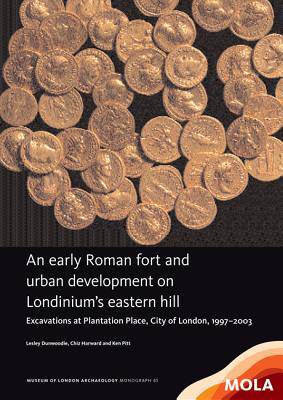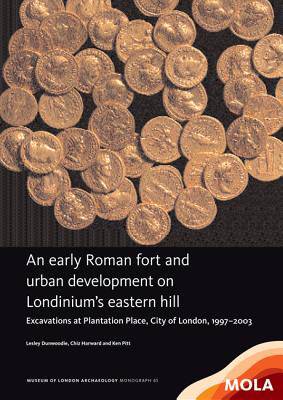
- Afhalen na 1 uur in een winkel met voorraad
- Gratis thuislevering in België vanaf € 30
- Ruim aanbod met 7 miljoen producten
- Afhalen na 1 uur in een winkel met voorraad
- Gratis thuislevering in België vanaf € 30
- Ruim aanbod met 7 miljoen producten
Zoeken
An Early Roman Fort and Urban Development on Londinium's Eastern Hill
Excavations at Plantation Place, City of London, 1997-2003
Lesley Dunwoodie, Chiz Harward, Ken Pitt
€ 41,95
+ 83 punten
Omschrijving
Excavation in 1997-2003 produced important new evidence for the development of Roman London. The site lay north-east of the bridge, towards the edge of the early town. Sparse commercial and domestic ribbon development here alongside early roads was ended by the Boudican revolt of AD 60/61. The military response is shown by the discovery of a previously unknown Roman military fortification, constructed over and partly out of the destroyed buildings. This is interpreted as part of an earthwork and timber fort, built c AD 63 in the aftermath of the revolt to secure the site of the devastated town and as a base for personnel involved in the reconstruction. The excavation produced a large collection of military artifacts, including plate armor (lorica segmentata), fittings and part of a cavalry helmet.
The fort survived until c AD 85, possibly 'mothballed' or 'squatted' after c AD 70, before it was cleared to make way for civilian domestic and commercial buildings. These were destroyed in the Hadrianic fire of c AD 125 and the redeveloped area was dominated by a substantial masonry townhouse, demonstrating the changing character of the town. The building may have housed a wealthy merchant or provincial official; a cellar contained a hoard of 43 gold aureii concealed in or after AD 174. This complex survived, much modified, into the later 4th century AD.
The fort survived until c AD 85, possibly 'mothballed' or 'squatted' after c AD 70, before it was cleared to make way for civilian domestic and commercial buildings. These were destroyed in the Hadrianic fire of c AD 125 and the redeveloped area was dominated by a substantial masonry townhouse, demonstrating the changing character of the town. The building may have housed a wealthy merchant or provincial official; a cellar contained a hoard of 43 gold aureii concealed in or after AD 174. This complex survived, much modified, into the later 4th century AD.
Specificaties
Betrokkenen
- Auteur(s):
- Uitgeverij:
Inhoud
- Aantal bladzijden:
- 260
- Taal:
- Engels
- Reeks:
- Reeksnummer:
- nr. 65
Eigenschappen
- Productcode (EAN):
- 9781907586323
- Verschijningsdatum:
- 27/05/2016
- Uitvoering:
- Hardcover
- Formaat:
- Genaaid
- Afmetingen:
- 211 mm x 300 mm
- Gewicht:
- 1338 g

Alleen bij Standaard Boekhandel
+ 83 punten op je klantenkaart van Standaard Boekhandel
Beoordelingen
We publiceren alleen reviews die voldoen aan de voorwaarden voor reviews. Bekijk onze voorwaarden voor reviews.











